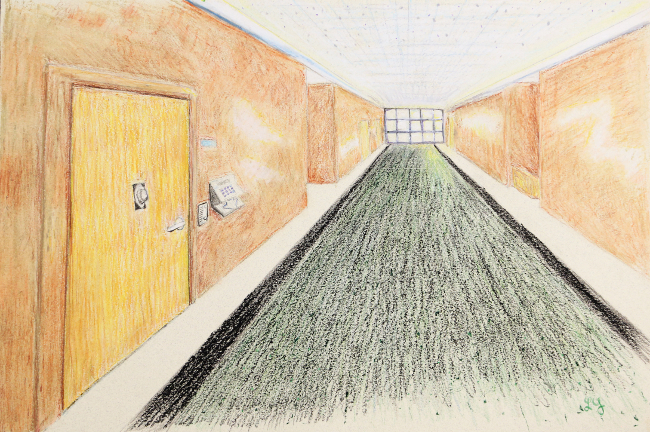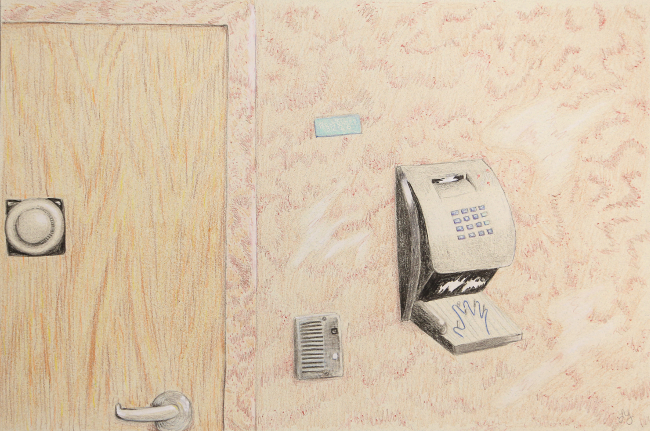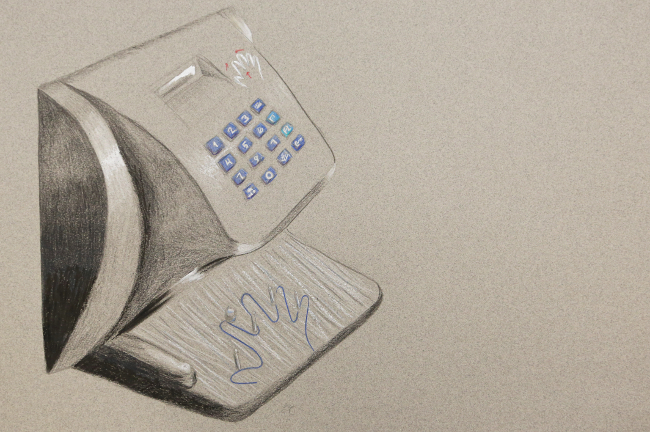The Door to the FISA Court
published by Eric Mill on
Nobody will actually tell you where the door to the Foreign Intelligence Surveillance Court — also known as the "FISA Court" — is. It's understood to have moved from the Department of Justice to the E. Barrett Prettyman Courthouse in 2009, but when I visited Prettyman, the employees in the first floor District Clerk's office (gently) laughed at my attempts to find anything about the Court. They referred to it as the "Room of Requirement", and said they had no idea what floor it was even on.
But if you walk through each floor of the Courthouse, and if you believe the Washington Post's 2009 description of the FISA Court door as having "biometric hand scanners" and being in a "public hallway", then it becomes pretty obvious that on the 3rd floor's solemn hallway, you've found your door:


I can only show you a drawing, because one of the first things that happens when you walk into the Prettyman Courthouse is they take away your phone. Unless you're staff or a juror, no recording devices allowed. Tip: the nicer you dress, the less likely they are to ask you about your business there. Your laptop and phone will get put in a little metal locker along with your photo ID, and you'll be given a key to get them on the way out.
To the right of the door, next to the intercom and the small sign saying "Access Restricted", is a biometric hand scanner. It's (probably) a Schlage HandKey II, a device that quickly snapshots the three-dimensional bone and joint structure of the hand and matches it against previously registered snapshots.

There are actually two other doors with hand scanners — one right next to this one, and one across the hall — but only this door is also augmented with an intercom system and a grey safe dial.

The dial is seemingly featureless, but if you get close up you'll see a small black glass window on the top of the dial, facing up. The dial appears to be disabled during business hours; the glass window was blank, and an employee who entered the door while I was there simply scanned her hand and opened the door.
Several people I've described this to felt certain these protections were to meet the requirements of a "SCIF", the government's formal name for a room qualified to store classified information. Building a SCIF is complicated and expensive — the office of the Director of National Intelligence published a 156 page technical compliance manual. That Washington Post piece cites the FISA Court's new digs as a $2 million investment, an expense justified by the Court's ex-chief Judge Royce C. Lamberth as a way for the Court to get out of the belly of the Department of Justice and look its proper part as the judicial branch's independent enforcer.
Given that, and how fervently the Court wants to be seen as in service of the public and not the executive, it's absurd that the FISA Court's door should stand nameless and undocumented in a public hallway.
On top of that, there's no obvious way for the public to interact with even the Court's unclassified work. I visited Prettyman not just to gawk at the door, but to find paper versions of the documents the FISA Court has been filing at its official public docket. I've been tracking this docket over at @FISACourt. The Court invented their public docket on the fly back in June, and I'm very glad it exists, but from a public records standpoint, it's a mess. The Court publishes scanned image PDFs that are impossible to search through electronically. Some PDFs show up in multiple dockets, their publication times are only discernible from a clerk's physical stamp, and the links are unpredictable. It's not even clear whether the links or the site itself are permanent. (Note: Since publishing this post, the FISC launched a proper permanent website and now generally OCRs the text of the PDFs.)
Yet these ad hoc PDFs are the only public records we have from the Court. There's no Clerk's office to be found, and there is no email address: only a phone number buried in the middle of a PDF of the FISC's official Rules of Procedure. If you call it, you'll get a terse voicemail message thanking you for calling the Foreign Intelligence Surveillance Court, and a beep.
Should you want to actually use the FISA Court by filing a motion of some kind, the wall between the Court and the executive quickly becomes paper thin. Activist Jonathan Corbett wrote about how he left a message at the Court's number, and got a call back not from Court staff, but an employee from the Department of Justice. Others who have been involved with actually submitting filings in the Court's current public dockets have told me the same thing: they have to interact with the FISA Court through the Department of Justice.
If the Foreign Intelligence Surveillance Court is supposed to be an actual Court, functioning in the service of the public and the Constitution as an independent overseer of the executive branch, where is its public face? Where are its unclassified records? Why can't we talk to its Clerk?
And if nothing else: why won't it put its name on its door?
